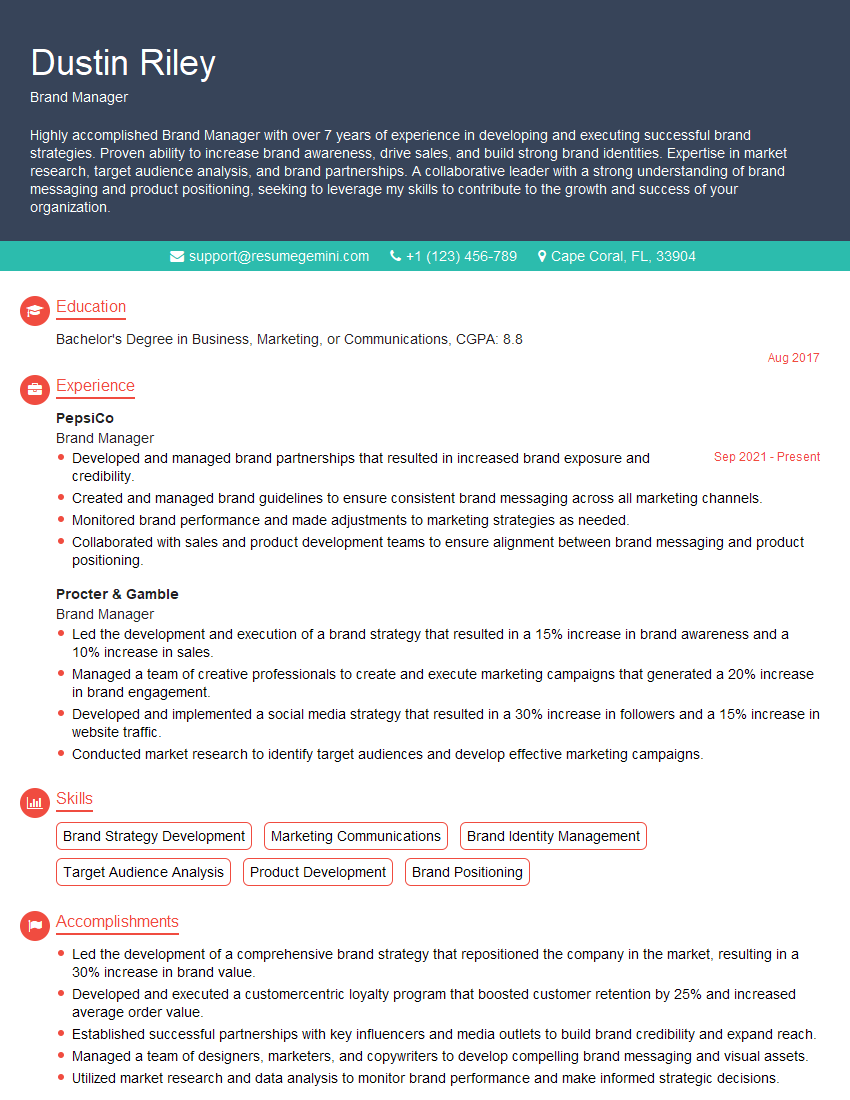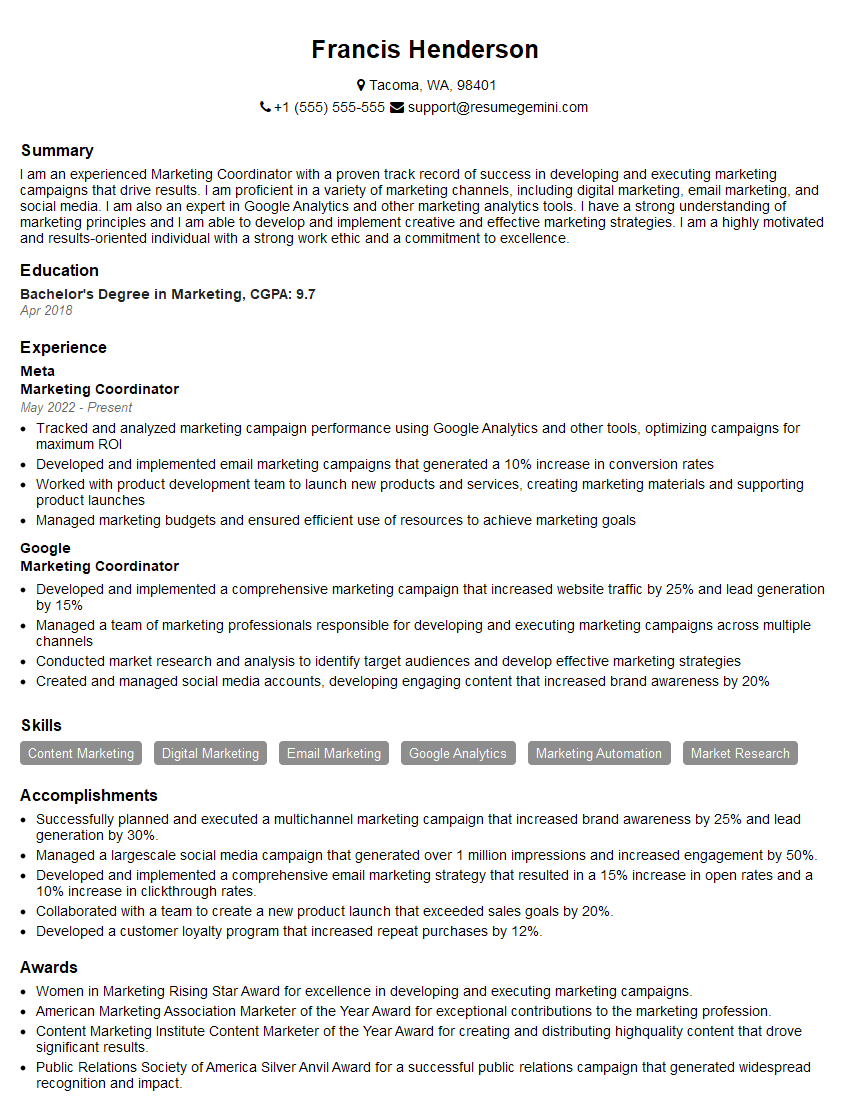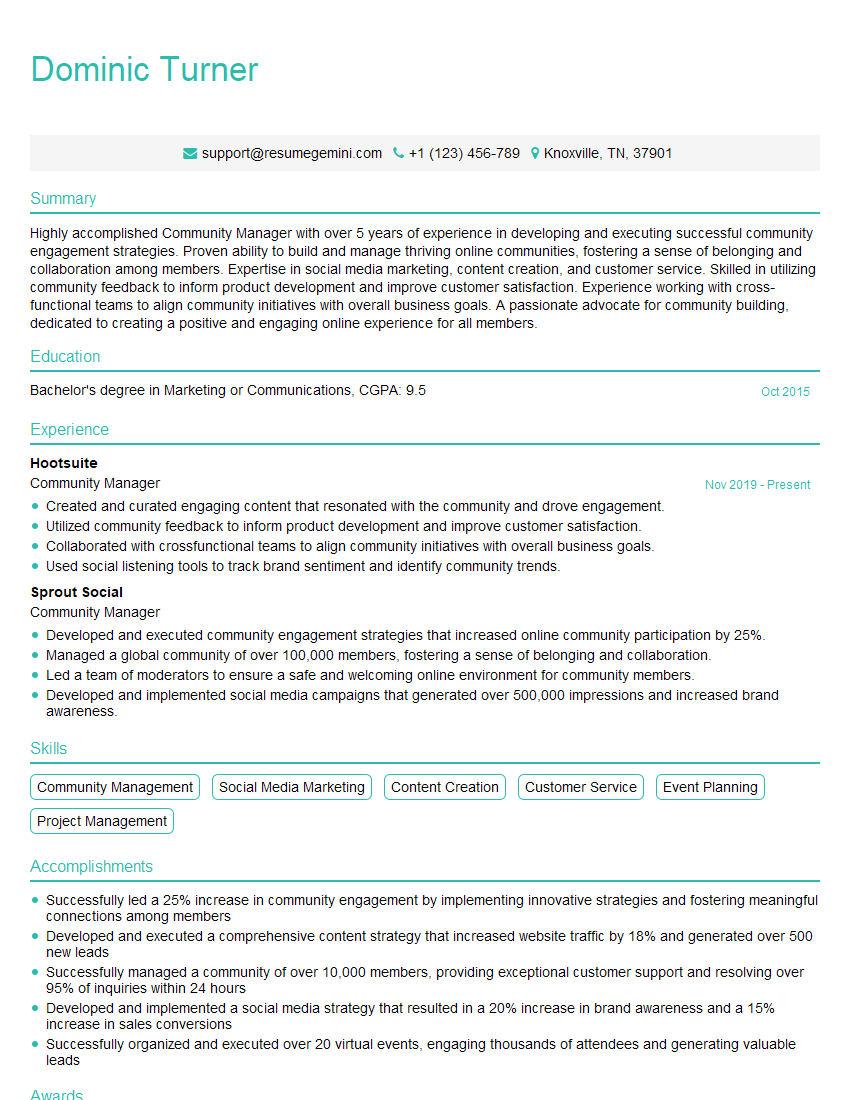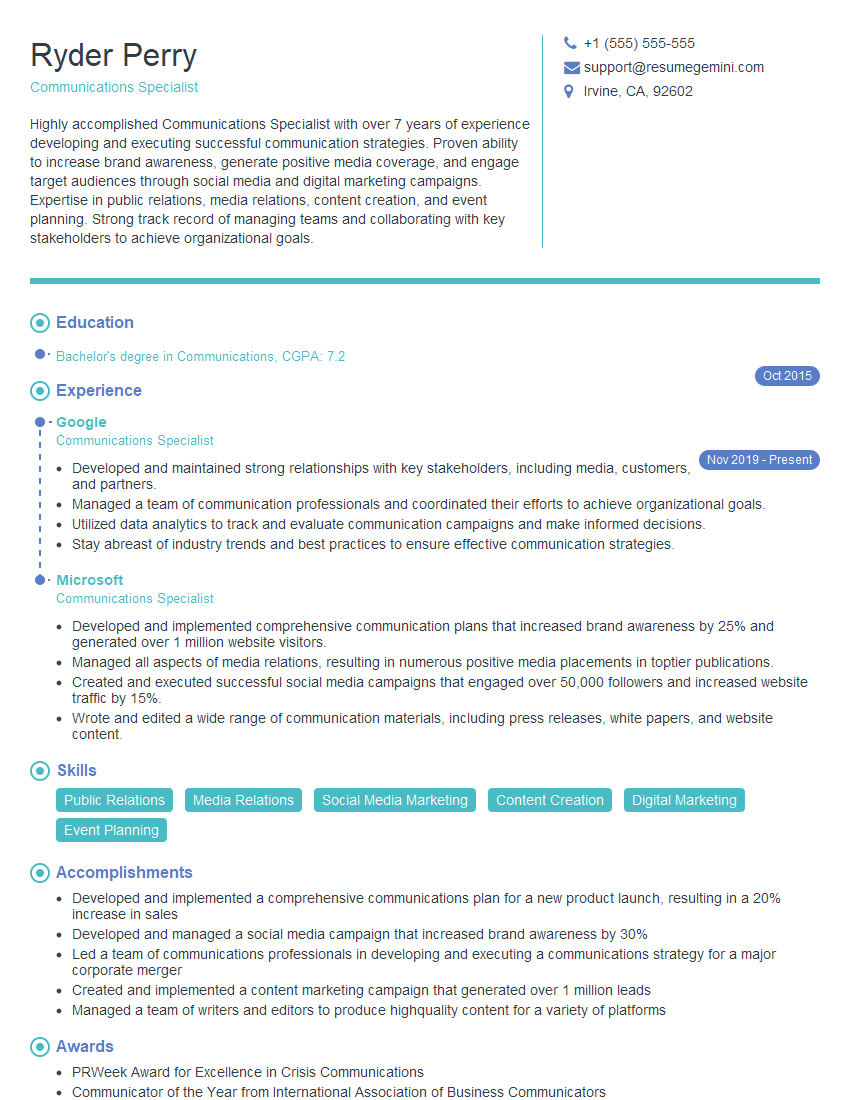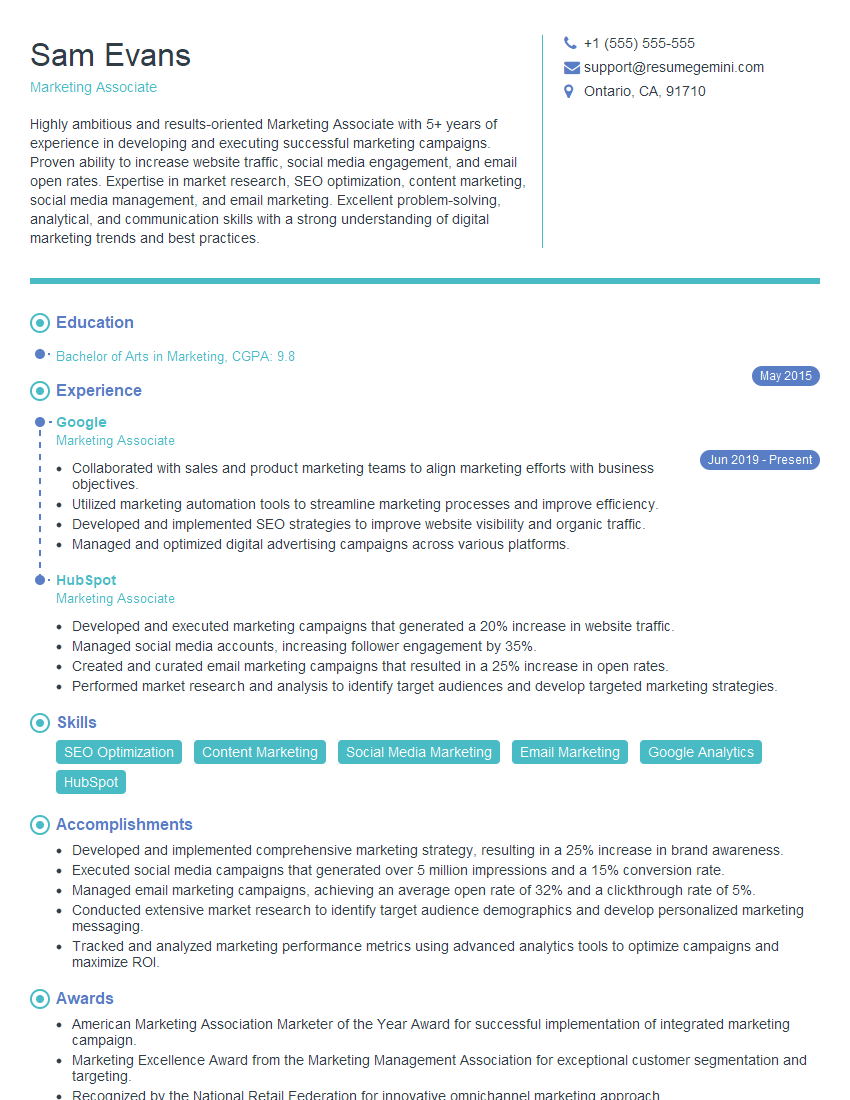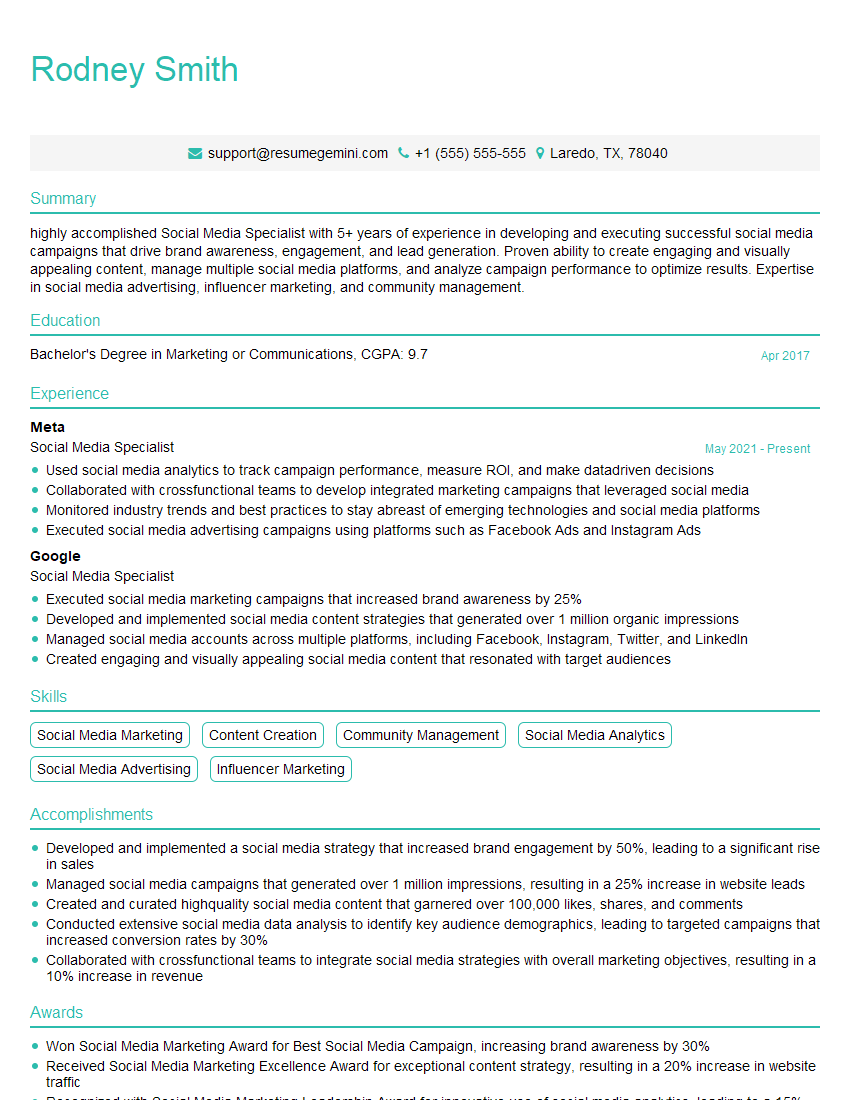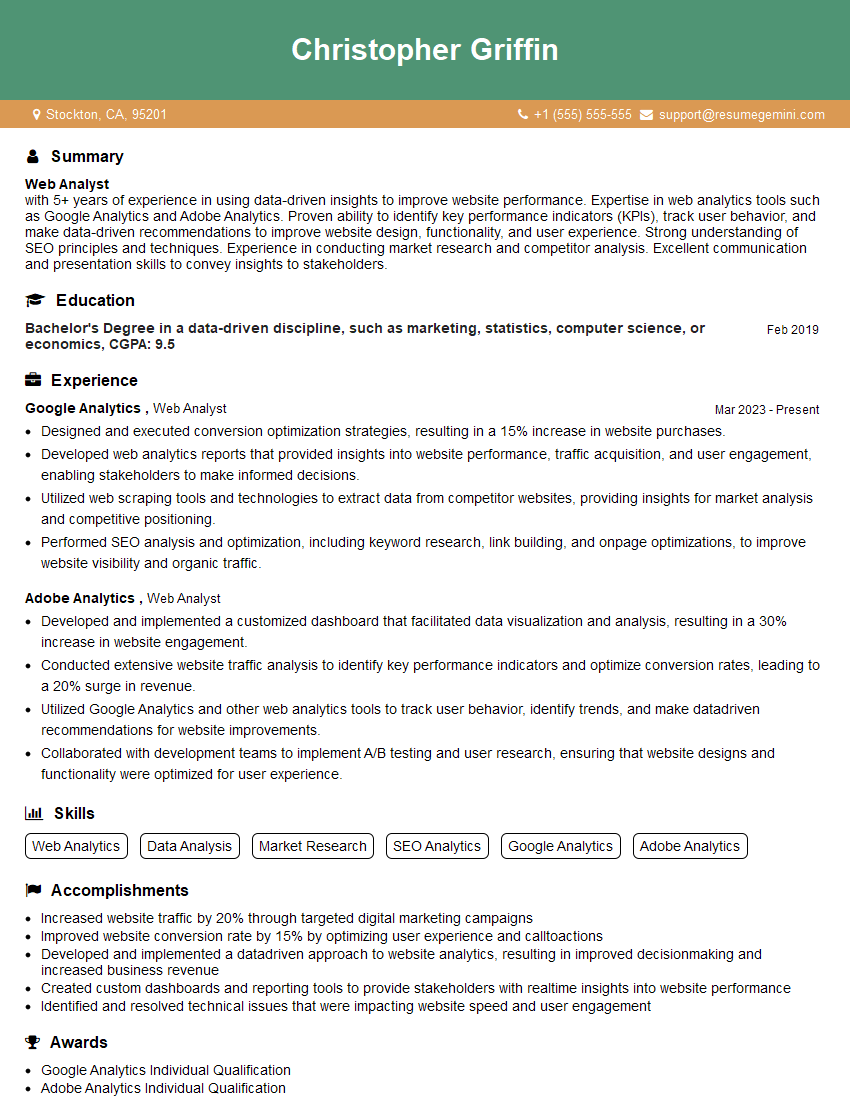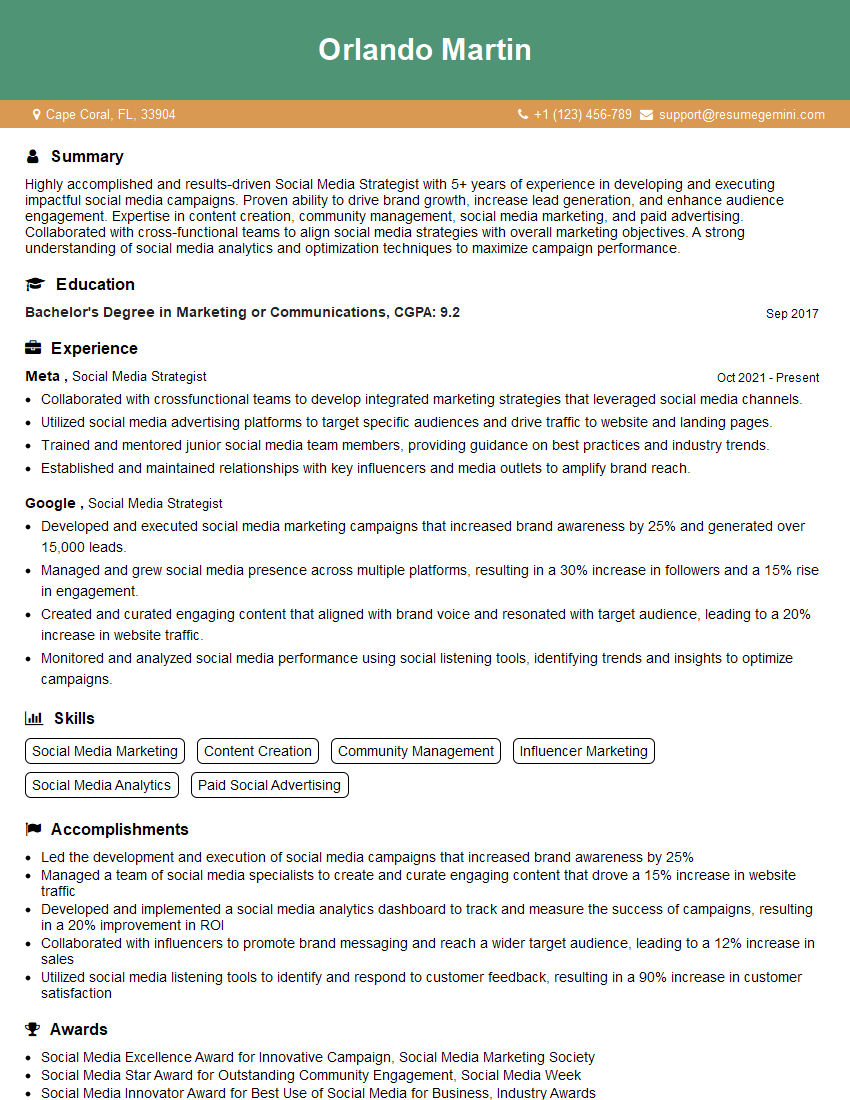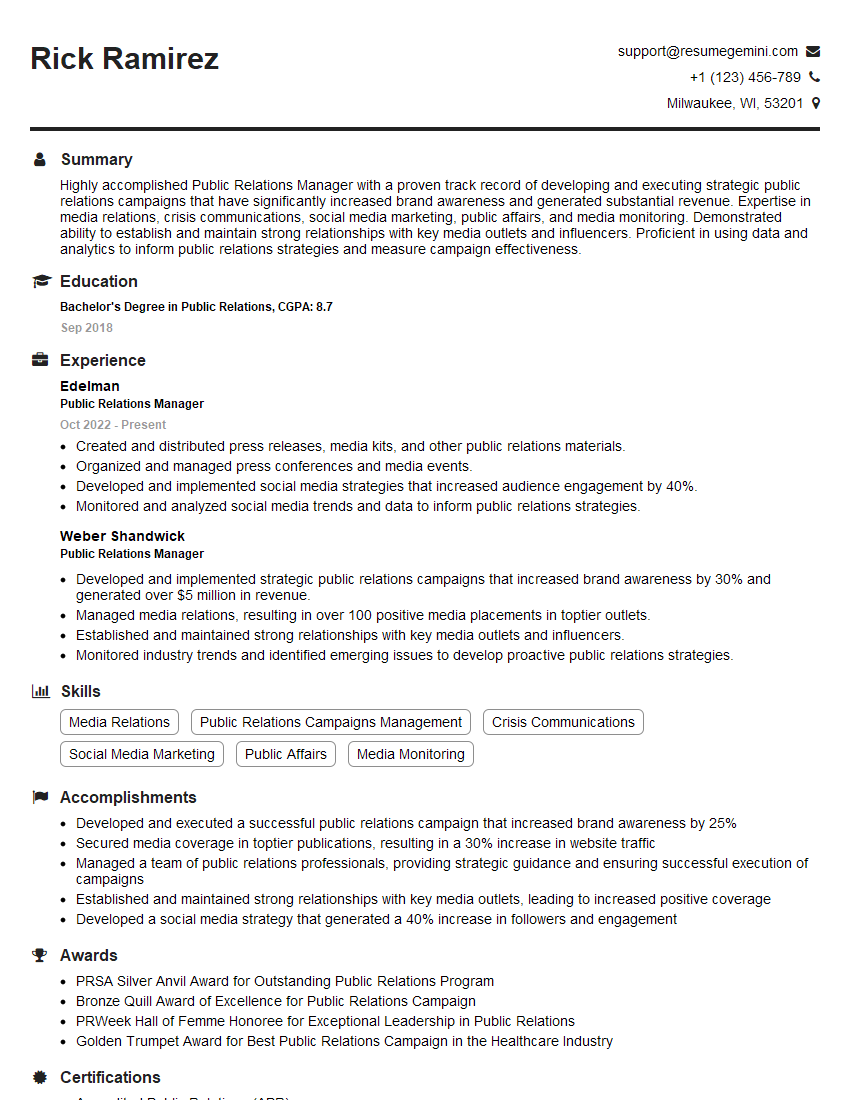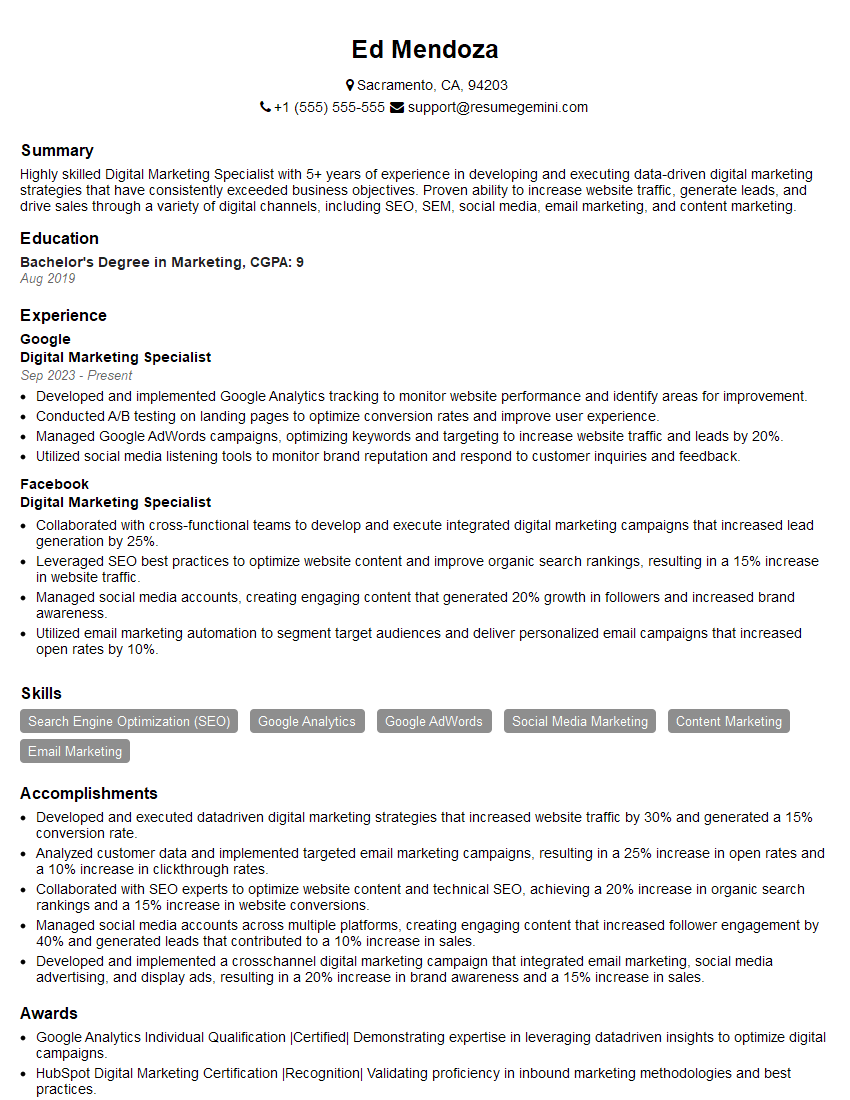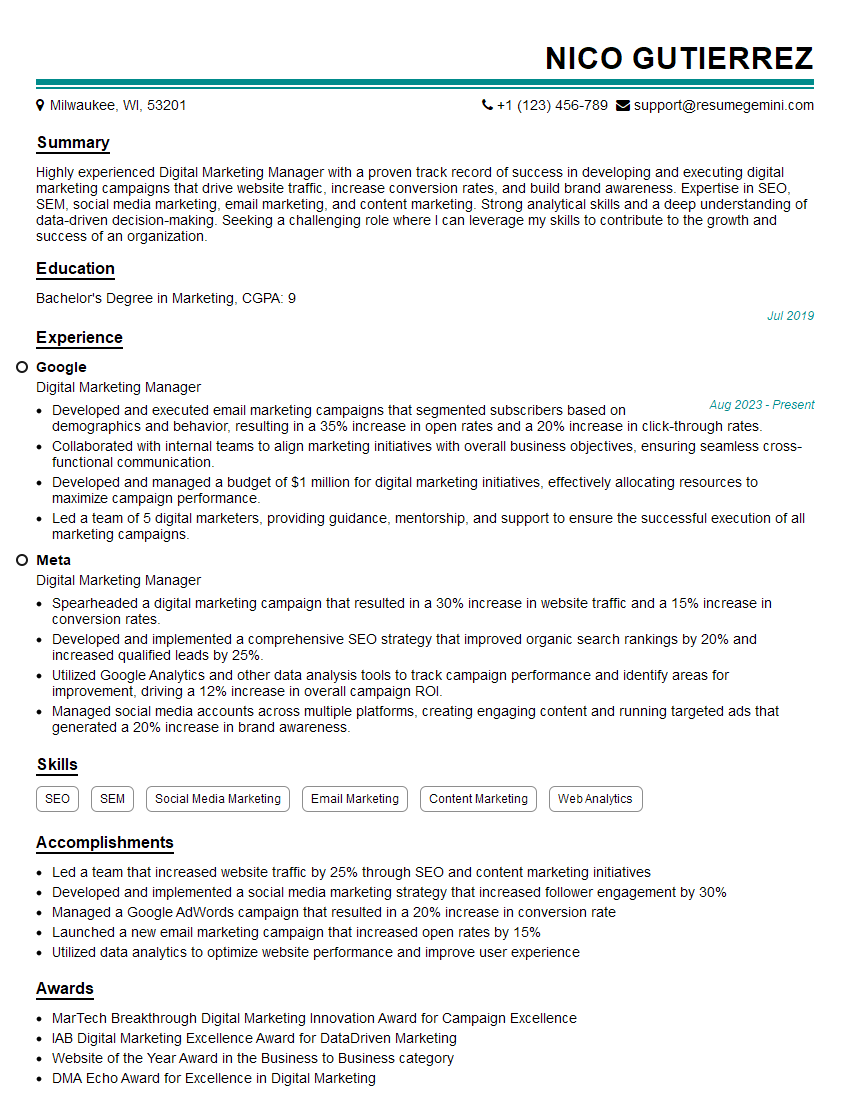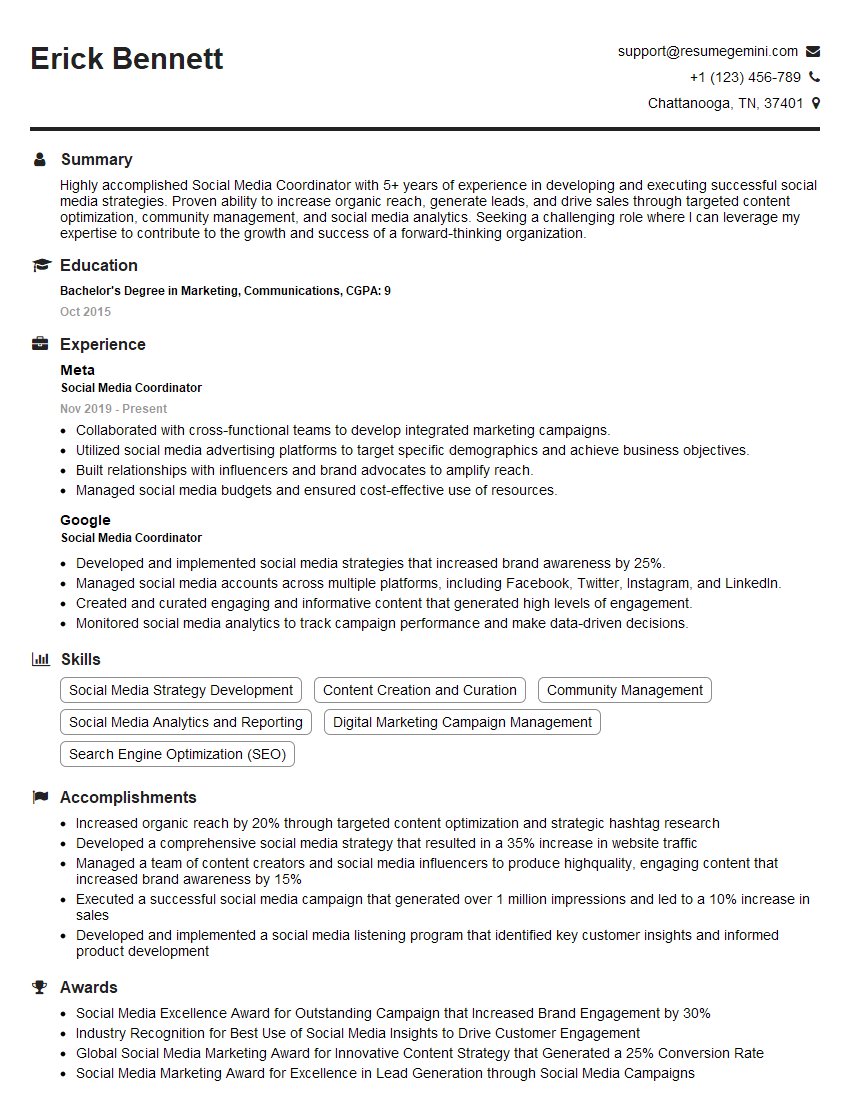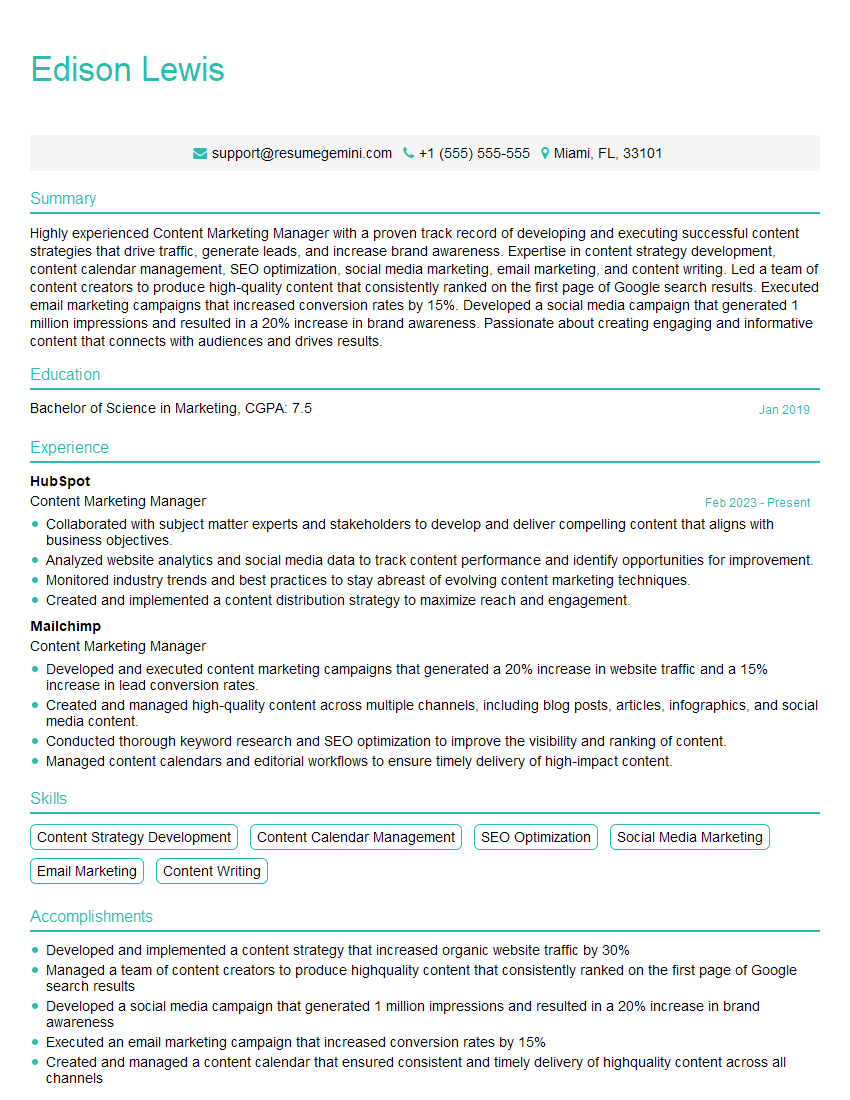The thought of an interview can be nerve-wracking, but the right preparation can make all the difference. Explore this comprehensive guide to Experience with social media platforms interview questions and gain the confidence you need to showcase your abilities and secure the role.
Questions Asked in Experience with social media platforms Interview
Q 1. What social media platforms are you most familiar with and why?
I’m most familiar with Facebook, Instagram, Twitter, LinkedIn, and TikTok. My selection isn’t arbitrary; it reflects the diverse audiences and marketing objectives these platforms serve. Facebook remains a powerful tool for reaching a broad demographic, particularly older audiences and those interested in community building. Instagram excels at visual storytelling, ideal for brands focused on aesthetics and lifestyle. Twitter’s real-time nature makes it perfect for news dissemination and engaging in immediate conversations. LinkedIn is essential for professional networking and B2B marketing. Finally, TikTok’s short-form video format offers unparalleled reach to younger demographics and allows for highly creative and engaging content.
My experience spans managing organic and paid campaigns across these platforms, analyzing performance data, and adapting strategies based on evolving algorithms and user behavior. For instance, I recently leveraged Instagram Reels to significantly boost engagement for a client in the beauty industry, achieving a 30% increase in follower growth within a quarter.
Q 2. Describe your experience with social media analytics tools (e.g., Google Analytics, Sprout Social).
I have extensive experience using various social media analytics tools, including Google Analytics, Sprout Social, and Hootsuite. Google Analytics provides valuable insights into website traffic originating from social media, allowing me to understand which platforms are driving the most conversions. Tools like Sprout Social and Hootsuite offer a more holistic view, providing detailed information on engagement metrics (likes, comments, shares), follower growth, brand mentions, and sentiment analysis.
For example, using Sprout Social, I identified a negative sentiment trend around a client’s new product launch. By analyzing the comments and utilizing the platform’s listening features, we were able to quickly address customer concerns and mitigate potential damage to brand reputation. This involved creating targeted content addressing the issues and proactively engaging with users expressing negative feedback.
Q 3. How do you measure the success of a social media campaign?
Measuring the success of a social media campaign depends on the defined objectives. It’s not solely about vanity metrics like likes and follower count. Instead, success hinges on achieving pre-determined goals. This might involve increasing brand awareness, driving website traffic, generating leads, boosting sales, or improving customer engagement and loyalty.
I typically employ a multi-faceted approach. First, I establish clear, measurable, achievable, relevant, and time-bound (SMART) goals before campaign launch. Next, I track relevant KPIs (Key Performance Indicators), comparing pre-campaign and post-campaign performance. Finally, I conduct a post-campaign analysis, identifying what worked, what didn’t, and providing actionable recommendations for future improvements. For example, a successful campaign for a food delivery service might be measured by the number of app downloads or orders resulting from the campaign, rather than just the number of likes.
Q 4. What are some common social media marketing KPIs?
Common social media marketing KPIs vary depending on the campaign objectives, but some key metrics include:
- Reach: The number of unique users who saw your content.
- Engagement: Interactions like likes, comments, shares, and saves. This indicates audience interest and involvement.
- Website Clicks: Tracking clicks from social media posts to your website, measuring the effectiveness of driving traffic.
- Conversion Rate: The percentage of users who complete a desired action (e.g., purchase, sign-up).
- Follower Growth: The increase in the number of followers over a specified period.
- Brand Mentions: Tracking mentions of your brand across social media to understand sentiment and reach.
- Customer Acquisition Cost (CAC): The cost of acquiring a new customer through social media marketing.
Analyzing these KPIs provides a holistic picture of campaign performance and informs future strategy adjustments.
Q 5. Explain your understanding of social media algorithms.
Social media algorithms are complex systems that determine which content users see in their feeds. They prioritize content based on various factors, including user engagement (likes, comments, shares), content relevance to user interests, account activity (frequency of logins, interactions), and the timeliness of posts. Each platform has its own unique algorithm, but common factors include:
- User Behavior: The algorithm learns what type of content a user interacts with most and prioritizes similar content.
- Content Quality: High-quality, engaging content is favored over low-quality content.
- Relationship Strength: Users are more likely to see content from accounts they regularly interact with.
- Timeliness: Recently posted content is often prioritized.
Understanding these algorithms is crucial for creating content that reaches the target audience. For example, posting high-quality videos at optimal times, when your target audience is most active, will increase the chances of your content appearing in their feeds.
Q 6. How do you stay up-to-date on the latest social media trends?
Staying up-to-date on social media trends requires a multi-pronged approach. I regularly follow industry influencers and thought leaders on various platforms, subscribe to relevant newsletters and podcasts, and actively participate in online communities and forums. I also utilize social media analytics tools to track emerging trends and monitor competitor activity. Furthermore, attending industry conferences and webinars is invaluable for understanding the latest developments and best practices.
A recent trend I’ve been following closely is the rise of short-form video content and the increasing importance of user-generated content in building brand authenticity. This has led me to integrate these elements into my social media strategies for clients, resulting in noticeable improvements in engagement and brand awareness.
Q 7. Describe your experience creating engaging social media content.
Creating engaging social media content is about understanding your target audience and delivering value. I focus on creating content that is relevant, informative, entertaining, and visually appealing. My approach involves a mix of content formats, including text, images, videos, stories, and live streams, depending on the platform and audience. I always consider the platform’s specific features and best practices when creating content.
For example, I recently developed a successful Instagram campaign for a local bakery using high-quality images of their products, combined with short, engaging captions and stories highlighting the baking process and customer testimonials. This resulted in a significant increase in both engagement and sales. I also consistently use A/B testing to optimize content performance, regularly analyzing metrics to identify what resonates most with the audience and refining my strategy accordingly.
Q 8. How do you handle negative comments or feedback on social media?
Handling negative comments requires a thoughtful and strategic approach. It’s not about deleting everything negative, but about turning criticism into an opportunity to improve and show your audience you care. My strategy involves a three-step process:
- Acknowledge and Empathize: I start by acknowledging the user’s feelings and validating their concerns. A simple, “I understand your frustration,” can go a long way. This shows you’re listening and taking them seriously.
- Address the Issue: I then directly address the specific issue raised in the comment. If it’s a valid complaint, I offer a sincere apology and explain what steps are being taken to rectify the situation. If it’s misinformation, I politely correct it with factual information and resources.
- Move the Conversation Offline (If Necessary): For complex or sensitive issues, I often offer to take the conversation offline via direct message or email. This allows for a more private and personal resolution, preventing public arguments.
For example, if someone complained about a faulty product, I wouldn’t just delete the comment. Instead, I’d apologize, offer a replacement or refund, and possibly thank them for bringing the issue to my attention, showcasing a commitment to customer satisfaction. This approach often turns a negative experience into a positive one, demonstrating professionalism and responsiveness.
Q 9. How do you identify and target your ideal audience on social media?
Identifying your ideal audience is crucial for effective social media marketing. It’s about understanding who you’re trying to reach and tailoring your content to resonate with them. My approach involves a combination of research and analysis:
- Analyze Existing Data: I start by analyzing existing data from your website, CRM, or previous marketing campaigns to identify common characteristics of your current customers. What are their demographics, interests, and online behavior?
- Competitor Analysis: I then research your competitors’ audiences. Who are they engaging with? What kind of content are they creating? This helps identify potential overlaps and unmet needs within your target market.
- Social Media Listening: I utilize social listening tools (more on that later) to identify conversations and trends related to your industry and products. This allows me to better understand the language and concerns of your target audience.
- Create Buyer Personas: Finally, I create detailed buyer personas – fictional representations of your ideal customers – based on the gathered information. These personas serve as a guide for creating targeted content and advertisements.
For instance, if you’re selling high-end athletic wear, your ideal audience might be affluent, health-conscious individuals aged 25-55, interested in fitness, outdoor activities, and sustainable brands. This understanding informs every aspect of the social media strategy, from the content created to the platforms used.
Q 10. What is your experience with social media advertising?
I have extensive experience managing and optimizing social media advertising campaigns across various platforms like Facebook, Instagram, Twitter, and LinkedIn. My expertise covers all stages of the process:
- Campaign Strategy & Goal Setting: I begin by defining clear, measurable goals for each campaign, aligning them with overall business objectives (e.g., increased brand awareness, lead generation, website traffic).
- Audience Targeting: I leverage each platform’s targeting options to reach the most relevant audiences based on demographics, interests, behaviors, and custom audience lists.
- Ad Creative Development: I create compelling ad creatives – images, videos, and copy – tailored to each platform and audience segment, ensuring they are visually appealing and effectively communicate the value proposition.
- Budget Allocation & Optimization: I allocate budgets efficiently across different campaigns and ad sets, constantly monitoring performance and adjusting bids to maximize ROI.
- Performance Tracking & Reporting: I meticulously track key metrics such as click-through rates, conversion rates, and cost per acquisition, providing regular reports and insights to clients.
I’ve successfully managed campaigns generating thousands of leads, significantly increasing brand awareness, and driving substantial website traffic. I’m proficient in A/B testing different ad creatives and targeting options to continuously improve campaign performance.
Q 11. Describe your experience with social media scheduling tools.
I’m proficient in using various social media scheduling tools, including Hootsuite, Buffer, and Sprout Social. These tools allow for efficient content planning and scheduling across multiple platforms, saving significant time and effort. My experience encompasses:
- Content Calendar Creation: I use these tools to create and maintain a consistent content calendar, ensuring a steady stream of engaging content across all platforms.
- Scheduling & Automation: I schedule posts in advance, ensuring consistent posting even outside of regular working hours. Some tools also offer automated posting features based on predefined rules.
- Team Collaboration: Many of these tools facilitate team collaboration, allowing multiple users to contribute to content creation and scheduling.
- Performance Analytics: I utilize the built-in analytics features to track post performance, identify what content resonates best with the audience, and inform future scheduling decisions.
For instance, using Buffer, I can schedule posts across different social media platforms from a single dashboard, saving time and ensuring consistency. The analytics features help identify what type of content performs better which informs my future strategies.
Q 12. How do you build and maintain a strong online community?
Building and maintaining a strong online community involves fostering engagement, creating a sense of belonging, and providing value to your audience. My approach focuses on several key elements:
- Consistent and Engaging Content: I create valuable, relevant, and entertaining content that sparks conversations and encourages interaction.
- Active Community Management: I actively engage with comments, messages, and questions, responding promptly and thoughtfully to build relationships with community members.
- Running Contests and Giveaways: Organizing contests and giveaways encourages participation and creates excitement around the brand.
- Utilizing Interactive Content Formats: I incorporate interactive content formats such as polls, quizzes, Q&A sessions, and live streams to increase audience engagement.
- Creating Closed Groups or Forums: For certain audiences, establishing a private group or forum provides a more exclusive and intimate space for community members to connect.
For example, I might host a weekly Q&A session on Instagram Live, allowing followers to ask questions directly. This not only provides valuable information but also fosters a sense of connection between the brand and its audience.
Q 13. How do you adapt your social media strategy based on platform-specific best practices?
Adapting to platform-specific best practices is critical for success on social media. Each platform has its own unique audience, content formats, and engagement patterns. My strategy involves:
- Understanding Platform Algorithms: I thoroughly understand the algorithms of each platform (e.g., Instagram’s emphasis on visual content, Twitter’s focus on real-time updates). This knowledge informs content creation and scheduling strategies.
- Optimizing Content for Each Platform: I tailor the content format, length, and style to suit each platform’s audience and conventions (e.g., short, engaging videos for TikTok, in-depth articles for LinkedIn).
- Utilizing Platform-Specific Features: I take full advantage of each platform’s unique features – Instagram Stories, Facebook Groups, Twitter polls, LinkedIn articles – to maximize engagement.
- Monitoring Platform Analytics: I closely monitor platform-specific analytics to track performance and identify areas for improvement. This iterative process ensures ongoing optimization.
For example, I would use short, engaging videos and reels on Instagram, focusing on visually appealing content, while posting longer, more in-depth articles and discussions on LinkedIn to connect with a professional audience.
Q 14. What experience do you have with social listening tools?
Social listening tools, such as Brandwatch, Talkwalker, and Mention, are invaluable for understanding what’s being said about your brand and industry online. My experience with these tools includes:
- Brand Monitoring: I use these tools to track mentions of your brand, products, and competitors across various social media platforms and online news sources.
- Sentiment Analysis: I analyze the sentiment expressed in these mentions (positive, negative, or neutral) to understand public perception of your brand.
- Competitive Analysis: I monitor competitor activity and identify trends to gain a competitive edge.
- Trend Identification: I use social listening to identify emerging trends and insights relevant to your industry, informing content strategies and marketing decisions.
- Crisis Management: In case of negative publicity or a crisis, social listening allows for early detection and swift response.
For example, by monitoring mentions of a competitor’s new product launch, I can identify public perception, understand what’s resonating with customers, and adapt our own marketing strategy accordingly. This proactive approach allows for timely adjustments and informed decision-making.
Q 15. How do you measure the ROI of a social media campaign?
Measuring the ROI of a social media campaign isn’t a simple task; it requires a multifaceted approach. Instead of focusing solely on vanity metrics like likes and shares, we need to tie social media activity to concrete business outcomes. This involves defining clear, measurable goals before the campaign even starts.
- Defining Objectives: What are we trying to achieve? Increased brand awareness? Lead generation? Website traffic? Sales? Each objective requires different metrics.
- Key Performance Indicators (KPIs): Once objectives are set, we select relevant KPIs. For example, if the goal is lead generation, we’d track form submissions, email sign-ups, or downloads from the social media platform. If it’s website traffic, we’d monitor clicks from social media to the website. For sales, we’d track conversions attributed to social media campaigns, possibly using UTM parameters in our links.
- Attribution Modeling: This is crucial. Social media rarely works in isolation. We need to understand how much credit to give social media for conversions that might also be influenced by other marketing channels. Various models exist (last-click, first-click, linear, etc.), and the best choice depends on the specific campaign and business.
- Analyzing Data: Tools like Google Analytics, social media platform analytics dashboards, and marketing automation platforms are essential for tracking data. We’ll analyze the data against our pre-defined KPIs and objectives, looking for trends and areas for improvement.
- Calculating ROI: The simplest formula is (Revenue generated from social media – Cost of the campaign) / Cost of the campaign. However, we must also consider indirect ROI, such as brand building or improved customer sentiment, which is harder to quantify but still very valuable.
Example: A campaign aimed at increasing website traffic might measure clicks, engagement rate, reach, and ultimately, conversions (e.g., purchases) from social media referrals. By tracking these and comparing the cost against the increase in sales, we get a solid picture of the campaign’s ROI.
Career Expert Tips:
- Ace those interviews! Prepare effectively by reviewing the Top 50 Most Common Interview Questions on ResumeGemini.
- Navigate your job search with confidence! Explore a wide range of Career Tips on ResumeGemini. Learn about common challenges and recommendations to overcome them.
- Craft the perfect resume! Master the Art of Resume Writing with ResumeGemini’s guide. Showcase your unique qualifications and achievements effectively.
- Don’t miss out on holiday savings! Build your dream resume with ResumeGemini’s ATS optimized templates.
Q 16. Describe a time you had to troubleshoot a social media crisis.
During a previous role, a misleading news article falsely accused our company of unethical labor practices. This went viral on Twitter, causing significant damage to our brand reputation and sparking negative comments and shares. Our immediate response was crucial.
- Rapid Assessment: We immediately assessed the damage, the speed of spread, and the sentiment of the comments. We used social listening tools to monitor the situation and identify key influencers driving the narrative.
- Fact-Checking & Response Strategy: We internally fact-checked the claims, gathered supporting evidence, and developed a calm, factual response addressing the concerns. We chose a professional and empathetic tone, avoiding defensiveness.
- Transparent Communication: We issued a public statement on all our social media platforms acknowledging the concern, providing the facts, and outlining the steps being taken to rectify the situation (even if it was simply clarifying the misunderstanding). We actively engaged with relevant comments and tweets, directly addressing concerns and providing clarification.
- Monitoring & Engagement: We continued to monitor the conversation for several days, actively addressing any new negative comments or misinformation. We leveraged positive comments and feedback to amplify our response.
- Proactive Measures: After the crisis subsided, we analyzed the event to identify potential weaknesses in our communications strategy and implemented improvements to prevent similar situations in the future.
This experience highlighted the importance of having a pre-defined crisis communication plan, incorporating clear lines of responsibility and escalation procedures. Having a quick and transparent response is key to mitigating reputational damage.
Q 17. How do you collaborate with other teams (e.g., sales, marketing) on social media projects?
Collaboration is paramount in social media marketing. I believe in fostering strong relationships with cross-functional teams, ensuring alignment on goals and effective communication.
- Sales Team: I work closely with sales to understand their current leads, pipeline, and customer insights. This allows for targeted social media campaigns that support sales efforts, such as promoting specific product offers or showcasing customer testimonials.
- Marketing Team: Regular meetings with the marketing team are essential to coordinate messaging, ensure brand consistency across all channels, and share campaign performance data. This includes aligning social media strategies with overall marketing objectives.
- Product Team: Collaborating with the product team helps me understand upcoming product launches, features, and updates, allowing for timely and relevant social media content.
- Customer Service Team: By staying connected with customer service, I gain valuable insights into customer feedback, complaints, and common questions, which helps in creating more effective and targeted social media content.
Effective communication tools, shared documents, and regular meetings are essential for successful collaboration. I often utilize project management software to track progress, assign tasks, and maintain transparency across teams.
Q 18. Explain your understanding of influencer marketing.
Influencer marketing involves partnering with individuals who have a significant following and influence over a specific target audience. These individuals, called influencers, can promote your brand, products, or services to their audience, increasing brand awareness, driving engagement, and generating leads.
- Identifying Influencers: The key is to identify influencers who align with your brand values and target audience. This requires research into their audience demographics, engagement rates, and overall content quality.
- Campaign Strategy: Develop a clear campaign strategy outlining the objectives, target audience, key performance indicators (KPIs), and budget. This will guide the selection of influencers and the type of content to be created.
- Influencer Selection: Consider factors like follower count, engagement rate, audience demographics, and the influencer’s overall credibility and authenticity. Don’t just focus on the largest numbers; engagement and relevance are more important.
- Content Creation & Collaboration: Work with chosen influencers to create engaging content that aligns with your brand guidelines and resonates with their audience. Transparency and clear communication are critical.
- Campaign Tracking & Measurement: Utilize tracking links, unique codes, and analytics tools to monitor the performance of the influencer campaign and assess its ROI. Track KPIs such as website traffic, lead generation, and sales.
Example: A sustainable clothing brand might collaborate with an eco-conscious fashion blogger to showcase their products to their environmentally conscious audience. This approach leverages the influencer’s established trust and credibility to reach a targeted segment effectively.
Q 19. What experience do you have with social media A/B testing?
A/B testing is essential for optimizing social media campaigns. It involves creating two or more versions of a social media post (or ad) and comparing their performance to determine which version is more effective. This helps identify the best-performing elements to maximize engagement and achieve desired outcomes.
- Defining Variables: Identify the elements you want to test. This might include the image or video used, the text of the caption, the call to action, or even the time of posting.
- Creating Variations: Develop variations of your social media post, changing only one element at a time to isolate its effect. A/B testing tools on platforms like Facebook and Twitter can streamline this process.
- Running the Test: Launch both versions of your post simultaneously to the same target audience. Ensure both versions have a sufficient sample size for statistically significant results.
- Analyzing Results: Once the test has run for a pre-defined period, analyze the results. Key metrics to look at include engagement rate (likes, comments, shares), clicks, conversions, and reach.
- Iterating and Optimizing: Based on the results, refine your approach. The winning variation should inform future social media strategies, and ongoing A/B testing should be part of a continuous optimization process.
Example: We might A/B test two different images for a product launch post, one showcasing the product in use and the other highlighting its key features. Analyzing the click-through rate and engagement metrics of each will help us determine which image is more effective.
Q 20. How familiar are you with social media compliance and regulations?
I’m very familiar with social media compliance and regulations. This is a crucial area that needs constant attention. Compliance varies based on location and platform, so staying up-to-date on the latest changes is critical.
- Data Privacy: Understanding and complying with regulations like GDPR (General Data Protection Regulation) and CCPA (California Consumer Privacy Act) is essential. This includes obtaining consent for data collection, providing transparency about data usage, and ensuring data security.
- Advertising Guidelines: Each platform (Facebook, Instagram, Twitter, etc.) has specific advertising guidelines that must be followed. This includes avoiding deceptive practices, targeting sensitive audiences appropriately, and ensuring ads are appropriately disclosed.
- Content Moderation: Appropriate content moderation policies are necessary to ensure that user-generated content aligns with your brand values and legal requirements. This includes addressing harmful or inappropriate content and responding to negative feedback responsibly.
- Copyright & Intellectual Property: It’s crucial to respect copyright laws and use only appropriately licensed images, videos, and other content. Avoiding plagiarism and obtaining necessary permissions are essential.
- FTC Guidelines (for advertising): The Federal Trade Commission (FTC) in the United States has guidelines regarding endorsements and testimonials, requiring transparency and disclosure of sponsored content.
Staying informed about these regulations is an ongoing process. I regularly consult legal resources and industry best practices to ensure compliance. Non-compliance can lead to significant penalties and damage to brand reputation.
Q 21. Describe your experience with social media content repurposing.
Social media content repurposing involves transforming existing content into different formats or using it across various platforms. This is a cost-effective way to maximize the value of your content and reach a wider audience.
- Repurposing Strategies: A blog post can be turned into a series of Instagram carousel posts, a Twitter thread, or even short-form video content for TikTok or YouTube Shorts. Infographics can be repurposed into presentations, social media graphics, or even email newsletters.
- Adapting Content for Different Platforms: It’s crucial to adapt content to suit the specific format and audience of each platform. A long-form blog post will require significant adaptation for a short-form video, for example.
- Maintaining Brand Consistency: While repurposing content, maintaining a consistent brand voice and visual identity across all platforms is crucial. This ensures brand recognition and audience engagement.
- Tools and Technologies: Several tools can streamline the repurposing process, from video editing software to graphic design tools. Understanding these tools and utilizing them effectively is key.
- Analyzing Performance: It’s important to track the performance of repurposed content and assess its effectiveness across different platforms. This allows for continuous optimization and improvement of future repurposing strategies.
Example: A webinar recording can be edited into short, engaging clips for Instagram Reels or TikTok, with accompanying text captions highlighting key takeaways. The original webinar slides can be transformed into a visually appealing infographic for LinkedIn or Pinterest.
Q 22. How do you prioritize tasks when managing multiple social media accounts?
Prioritizing tasks across multiple social media accounts requires a strategic approach. I use a combination of methods, starting with a clear understanding of each platform’s goals and audience. I then employ a system that prioritizes time-sensitive tasks, such as responding to customer inquiries or addressing urgent brand mentions. I find tools like Trello or Asana incredibly helpful for visualizing my workflow and assigning deadlines. For instance, if a campaign launch on Instagram is imminent, that will naturally take precedence over scheduling a month-ahead tweet. I also factor in the platform’s algorithm; content requiring more immediate attention (like Instagram Stories) is given priority over evergreen content (like LinkedIn articles).
- Urgency/Time Sensitivity: Responding to comments and direct messages always comes first.
- Platform Algorithm: Understanding peak engagement times for each platform dictates scheduling.
- Campaign Deadlines: Major campaigns will take precedence over routine tasks.
- Impact/Reach: High-impact content with larger potential reach gets prioritized.
Ultimately, it’s about effective time management and strategic delegation if resources allow.
Q 23. What strategies do you use to improve social media engagement?
Improving social media engagement is a multifaceted process, focusing on creating high-quality content, fostering community interaction, and leveraging data-driven insights. I utilize a blend of strategies that include:
- Engaging Content Formats: Using diverse content, such as videos, polls, quizzes, and interactive stories, keeps the audience involved. For example, I’ve used Instagram Reels to showcase behind-the-scenes glimpses, significantly boosting engagement.
- Interactive Content: Asking questions, running polls, and hosting Q&A sessions encourage participation and build a community. A recent LinkedIn poll I conducted on industry trends generated a great deal of conversation.
- Strategic Use of Hashtags: Employing relevant and trending hashtags increases the visibility of posts and expands reach. Research is key to finding the best combination for each platform and post.
- Community Building: Responding promptly to comments and messages creates a strong sense of connection and builds brand loyalty. I make it a point to engage personally and authentically.
- Influencer Marketing (where applicable): Collaborating with relevant influencers can introduce the brand to a wider audience, boosting awareness and engagement.
- Data Analysis: Using analytics to understand audience preferences and adjust content strategy accordingly is paramount for sustained growth.
It’s an iterative process; what works today might not tomorrow. Continuous monitoring and adaptation are essential.
Q 24. Explain your experience with social media reporting and analytics.
I have extensive experience with social media reporting and analytics. I’m proficient in using native platform analytics (like Facebook Insights, Instagram Insights, etc.) as well as third-party tools such as Google Analytics and dedicated social media management platforms (e.g., Hootsuite, Sprout Social). My approach involves setting clear KPIs (Key Performance Indicators) from the outset, aligning with overarching business objectives. This might include metrics like reach, engagement rate, website clicks, lead generation, and brand mentions. I regularly track these metrics and create reports that highlight key trends, successes, and areas for improvement.
For example, I once identified a drop in engagement on a particular platform. By analyzing the data, I discovered a change in the platform’s algorithm was affecting our reach. We then adjusted our content strategy, including experimenting with different posting times and content formats, resulting in a significant improvement.
My reports typically include visualizations (charts and graphs) to make the data easily digestible and actionable, allowing for data-driven decision-making. I always ensure my reporting is concise, clear, and tailored to the audience receiving it.
Q 25. How familiar are you with different social media advertising platforms (e.g., Facebook Ads, LinkedIn Ads)?
I am highly familiar with various social media advertising platforms, including Facebook Ads, LinkedIn Ads, Twitter Ads, and Instagram Ads. I understand the nuances of each platform, such as audience targeting options, campaign objective selection, and ad formats. I have experience creating and managing campaigns across these platforms, from designing ad creatives to optimizing bidding strategies.
My approach focuses on a data-driven strategy; starting with defining clear objectives, identifying the target audience, and crafting compelling ad copy. I then use A/B testing to optimize ad performance. For instance, when running a LinkedIn Ads campaign for B2B lead generation, I would prioritize targeting specific job titles and industries, using a strong call-to-action focused on downloadable content or a consultation.
I also understand the importance of ad budget allocation and tracking ROI (Return on Investment). I regularly monitor campaign performance and make adjustments as needed to maximize efficiency and effectiveness. This includes managing ad spend, adjusting bidding strategies, and refining targeting parameters.
Q 26. Describe your process for creating a social media content calendar.
Creating a social media content calendar is a crucial aspect of maintaining a consistent and engaging social media presence. My process involves several steps:
- Define Goals & Objectives: What are the overarching goals for social media? This will inform content strategy.
- Audience Research: Understanding audience demographics, interests, and preferred content formats is paramount.
- Content Ideation: Brainstorming content ideas aligned with goals and audience preferences. This might involve using mind maps, keyword research, or trend analysis.
- Theme Planning: Grouping content around recurring themes or topics ensures consistency and helps build a cohesive brand narrative.
- Content Scheduling: Using a scheduling tool (like Hootsuite or Buffer) to plan posts across various platforms, optimizing for peak engagement times.
- Asset Creation: Developing high-quality images, videos, and written content.
- Review & Refinement: Regularly reviewing the calendar to make adjustments based on performance data and emerging trends.
I typically use a spreadsheet or dedicated content calendar software to manage the process. This allows for easy visualization, collaboration, and tracking of progress. The calendar isn’t set in stone; it’s a living document adapted based on real-time data and opportunities.
Q 27. What is your experience with using social media for customer service?
I have significant experience using social media for customer service. It’s a powerful tool for building relationships, resolving issues, and providing immediate support. My approach is centered on prompt and personalized responses. I make it a priority to monitor brand mentions, respond to queries, and address complaints effectively and empathetically. This often involves using a combination of direct messaging, public replies, and, if necessary, escalating issues to the appropriate internal teams.
I believe in transparency and open communication; addressing negative feedback publicly and turning these interactions into opportunities to showcase customer-centricity and problem-solving skills. I also use social listening tools to track mentions and sentiment, proactively identifying and addressing potential issues before they escalate. For example, I’ve successfully resolved several customer issues through social media, turning initially frustrated customers into brand advocates.
For efficiency, I often establish clear guidelines and escalation protocols to ensure rapid response times and seamless issue resolution. This includes assigning different team members to monitor specific platforms and designating a dedicated social media inbox for easier management.
Q 28. How do you ensure brand consistency across all social media platforms?
Maintaining brand consistency across all social media platforms is crucial for building a strong and recognizable brand identity. My approach involves creating a comprehensive brand style guide that outlines key elements such as:
- Brand Voice & Tone: Defining the personality and style of communication used across all platforms.
- Visual Identity: Establishing consistent use of logos, colors, fonts, and imagery.
- Content Pillars: Defining key topics and themes that will be consistently addressed.
- Hashtags & Keywords: Identifying and consistently using brand-specific hashtags and keywords.
I also ensure that the messaging and visual elements are consistent across platforms, even though the content format may vary. This means adapting the same core message to suit each platform’s unique style and audience. For instance, a formal announcement on LinkedIn might be shared as a more casual video on Instagram, but both maintain the same core brand message and visual identity. Regular review and updates to the brand style guide ensure everyone on the team is on the same page and that the brand remains consistent over time.
Key Topics to Learn for Social Media Platform Experience Interviews
- Social Media Strategy & Planning: Understanding how to develop and implement effective social media strategies aligned with business goals. This includes audience research, competitor analysis, and setting measurable objectives.
- Content Creation & Curation: Developing engaging and relevant content across various platforms (e.g., text, images, video). This involves understanding different content formats and their optimal use on each platform.
- Community Management & Engagement: Building and nurturing online communities. This includes responding to comments, addressing concerns, and fostering positive interactions with followers.
- Social Media Advertising & Analytics: Running and optimizing paid social media campaigns. This encompasses understanding various ad formats, targeting options, and analyzing campaign performance using relevant metrics.
- Platform-Specific Best Practices: Demonstrating familiarity with the unique features and functionalities of popular platforms like Facebook, Instagram, Twitter, LinkedIn, TikTok, etc. This includes understanding algorithm updates and best practices for each platform.
- Social Listening & Brand Monitoring: Tracking mentions of your brand or industry online to understand public perception and identify potential crises. This involves using social listening tools and analyzing sentiment.
- Measuring ROI & Reporting: Tracking key performance indicators (KPIs) and reporting on the effectiveness of social media activities. This includes presenting data-driven insights to stakeholders.
- Legal & Ethical Considerations: Understanding and complying with relevant regulations and best practices related to data privacy, intellectual property, and brand reputation.
- Problem-solving & Case Studies: Being prepared to discuss how you’ve overcome challenges related to social media management and demonstrate your problem-solving skills through real-world examples.
Next Steps
Mastering social media platforms is crucial for career advancement in today’s digital landscape. Proficiency in this area significantly enhances your marketability across diverse industries. To increase your job prospects, focus on creating an ATS-friendly resume that highlights your skills and experience effectively. ResumeGemini is a trusted resource to help you build a professional and impactful resume. We provide examples of resumes tailored to social media platform experience to guide you through the process. Let ResumeGemini help you land your dream job!
Explore more articles
Users Rating of Our Blogs
Share Your Experience
We value your feedback! Please rate our content and share your thoughts (optional).
What Readers Say About Our Blog
Hello,
We found issues with your domain’s email setup that may be sending your messages to spam or blocking them completely. InboxShield Mini shows you how to fix it in minutes — no tech skills required.
Scan your domain now for details: https://inboxshield-mini.com/
— Adam @ InboxShield Mini
Reply STOP to unsubscribe
Hi, are you owner of interviewgemini.com? What if I told you I could help you find extra time in your schedule, reconnect with leads you didn’t even realize you missed, and bring in more “I want to work with you” conversations, without increasing your ad spend or hiring a full-time employee?
All with a flexible, budget-friendly service that could easily pay for itself. Sounds good?
Would it be nice to jump on a quick 10-minute call so I can show you exactly how we make this work?
Best,
Hapei
Marketing Director
Hey, I know you’re the owner of interviewgemini.com. I’ll be quick.
Fundraising for your business is tough and time-consuming. We make it easier by guaranteeing two private investor meetings each month, for six months. No demos, no pitch events – just direct introductions to active investors matched to your startup.
If youR17;re raising, this could help you build real momentum. Want me to send more info?
Hi, I represent an SEO company that specialises in getting you AI citations and higher rankings on Google. I’d like to offer you a 100% free SEO audit for your website. Would you be interested?
Hi, I represent an SEO company that specialises in getting you AI citations and higher rankings on Google. I’d like to offer you a 100% free SEO audit for your website. Would you be interested?
good
